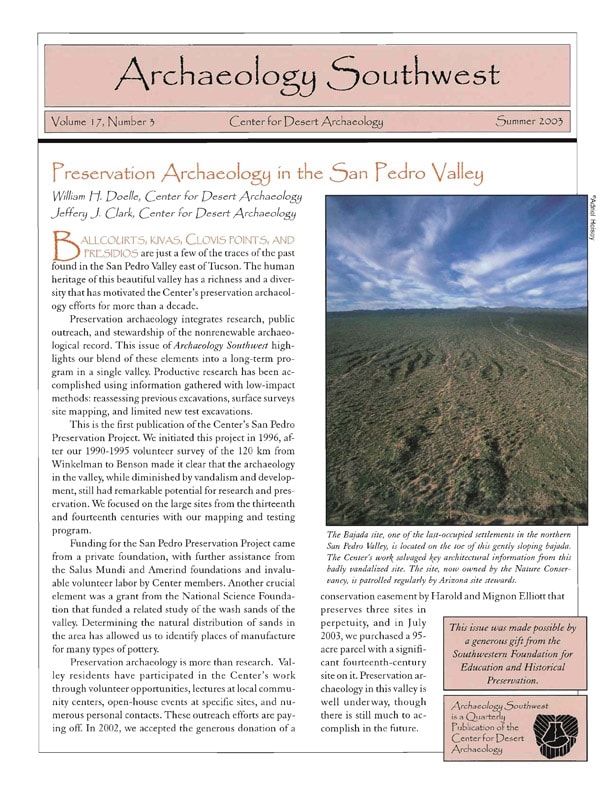Preservation Archaeology in the San Pedro Valley

The Bajada site, one of the last-occupied settlements in the northern San Pedro Valley, is located on the toe of this gently sloping bajada. The Center’s work salvaged key architectural information from this badly vandalized site. The site, now owned by the Nature Conservancy, is patrolled regularly by Arizona site stewards. Photograph © Adriel Heisey.
Archaeology Southwest Magazine Vol. 17, No. 3
Free PDF Download
William H. Doelle and Jeffery J. Clark,
Archaeology Southwest (formerly the Center for Desert Archaeology)
Ballcourts, kivas, Clovis points, and presidios are just a few of the traces of the past found in the San Pedro Valley east of Tucson. The human heritage of this beautiful valley has a richness and a diversity that has motivated the Center’s preservation archaeology efforts for more than a decade.
Preservation archaeology integrates research, public outreach, and stewardship of the nonrenewable archaeological record. This issue of Archaeology Southwest highlights our blend of these elements into a long-term program in a single valley. Productive research has been accomplished using information gathered with low-impact methods: reassessing previous excavations, surface surveys, site mapping, and limited new test excavations.
This is the first publication of the Center’s San Pedro Preservation Project. We initiated this project in 1996, after our 1990-1995 volunteer survey of the 120 km from Winkelman to Benson made it clear that the archaeology in the valley, while diminished by vandalism and development, still had remarkable potential for research and preservation. We focused on the large sites from the thirteenth and fourteenth centuries with our mapping and testing program.
Funding for the San Pedro Preservation Project came from a private foundation, with further assistance from the Salus Mundi and Amerind foundations and invaluable volunteer labor by Center members. Another crucial element was a grant from the National Science Foundation that funded a related study of the wash sands of the valley. Determining the natural distribution of sands in the area has allowed us to identify places of manufacture for many types of pottery.
Preservation archaeology is more than research. Valley residents have participated in the Center’s work through volunteer opportunities, lectures at local community centers, open-house events at specific sites, and numerous personal contacts. These outreach efforts are paying off. In 2002, we accepted the generous donation of a conservation easement by Harold and Mignon Elliott that preserves three sites in perpetuity, and in July 2003, we purchased a 95-acre parcel with a significant fourteenth-century site on it. Preservation archaeology in this valley is well underway, although there is still much to accomplish in the future.
This issue was made possible by a generous gift from the Southwestern Foundation for Education and Historical Preservation.
Issue Editors: William H. Doelle and Jeffery J. Clark, Center for Desert Archaeology
Articles Include:
- A Brief History of Lower San Pedro Archaeology – Jeffery J. Clark
- San Pedro, River of the Ancients – Bruce B. Huckell
- Ballcourts and Buff Wares – Henry D. Wallace
- Mounds and Migrants in the Classic Period – Jeffery J. Clark and Patrick D. Lyons
- Sands of the San Pedro Valley – Elizabeth J. Miksa and Jeffery J. Clark
- Perforated Plates – Patrick D. Lyons
- Cliff Polychrome – Patrick D. Lyons
- In Search of the Coronado Trail – Linda J. Pierce and Don Burgess
- Charles Di Peso and the Origins of Sobaipuri Pima – James M. Vint
- The Life and Times of Santa Cruz de Terrenate – J. Homer Thiel and James M. Vint
- Picturing the Past: Images, History, and Place in the San Pedro Valley – Chip Colwell-Chanthaphonh
- Tribute to Mignon Elliott and Back Sight – William H. Doelle
Subscribe

